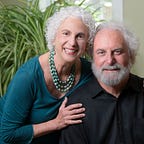Sympathetic Joy
Part 1: What Do I Do with Envy?
Linda: Max was born with a malformed heart, which curtailed his participation in vigorous sports. His father, uncle, and male cousins were athletic, pitting themselves against other teams in soccer, basketball, football, and track while Max was confined to golf. He tried his best to be a good sport about it, but he was filled with envy of their health that allowed them the unrestrained activity he longed for.
Marsha was 30 and single. All her closest women friends were married or in committed partnerships. She had a long string of relationships that didn’t work out. She had been a bridesmaid six times in seven years. She did her best to be happy for her friends, but when she saw couples she knew, or even complete strangers in public walking holding hands, embracing, or kissing, her envy of their connections reverberated through her body. She longed for what they had.
Selma worked hard at her job. She felt that she was achieving in the workplace, yet those she deemed less adequate in their job performance got promotions. Once a year, there was a gathering to give out awards to the highest performing employees. Some received plaques and others won trips to Las Vegas and New Orleans. It was at the award ceremonies when her envy was most acute.
Each of these people had their well-being compromised until they were offered an ancient technique called Sympathetic Joy. Sympathetic Joy is a method of cultivating the opposite of envy or jealousy of others, replacing the uncomfortable feelings with happiness for them. It’s a simple technique, but we all know that simple is not necessarily easy.
They each took on the practice. In the first phase, Max imagined himself playing golf, excelling at the game. Marsha imagined herself falling in love with a man who loved her back, and Selma visualized making more sales for her company and receiving a plaque at the awards ceremony. They let the joy of imagining these sweet scenes flow through them.
Their next task was to imagine someone they love having a wonderful experience and consciously choosing to feel joy flow through them. The first two phases of the practice were fairly easy for each of them. The next phase was a bit more difficult. They brought to mind a complete stranger, imagining something wonderful happening to that person and allowing themselves to feel joyful for the stranger.
Then they brought to mind a person they did not like. When they imagined something good happening to them, the task was the same, to feel joy on their behalf. The instructions say to make your best effort to feel the same happiness you feel for your own good fortune or for those you love.
The last phase of the visualization is to bring to mind a person you dislike intensely. You make your best effort to feel joy even if you regard that person as your enemy. You may even hate this person, and yet you do your best to feel joy on behalf of their success.
The meditation is only for 15 minutes a day, but it can feel a lot longer than that. At first, in the early weeks of practice, it appeared as if they were only going through the motions. But they each stayed with the practice until the results rolled in.
Max said, “Over the months of my practice, my perspective has switched from being keenly aware of what I don’t have to be sincerely grateful for what I do have. My parents knew of my heart defect when I was still in my mother’s womb and when the doctor told them how serious the condition was, they considered aborting me. I’m glad I got to live. I do enjoy playing golf and my life is full. I can get plenty of pleasure from cheering my dad, uncle, and cousins in their games.”
Marsha’s meditation practice brought her some relief. She said, “Prior to this spiritual practice, I didn’t know I had a choice about how I felt. I thought I was stuck with those yucky feelings. My girlfriends are a feisty, fun bunch. We still party even though they have partners, and a few have babies. It took many months of practice, but now I trust more that it’s just a matter of time until it’s my turn to find love. I’m getting to know their partners, and most of them are good guys. I am truly happy for them. I’m confident that my sweeter disposition puts me in a better position to find my own good man.
Selma continues to learn and improve her job performance. “When I realized the terrible toll it was taking on me to covet those prizes and the status that came with them, I understood that I had a choice. I set a clear intention to feel differently about my coworkers who were excelling at their jobs. It didn’t happen overnight; it took many months. Now that I’m not so angry with them, a few are offering me helpful tips about how to improve my job performance. Before I was thinking in terms of a zero-sum game, that if they had more, I had less. Now I see that there’s plenty of success and joy to go around for all of us.”
The Buddhists speak of cultivating the warm heart of compassion. As each of these three continued their practice, they felt their hearts expand into loving-kindness. Their envious hearts had transformed to tenderness, and with that tenderness, more joy poured into each of their lives.
We’re giving away 3 e-books absolutely free of charge. To receive them just click here. You’ll also receive our monthly newsletter.
